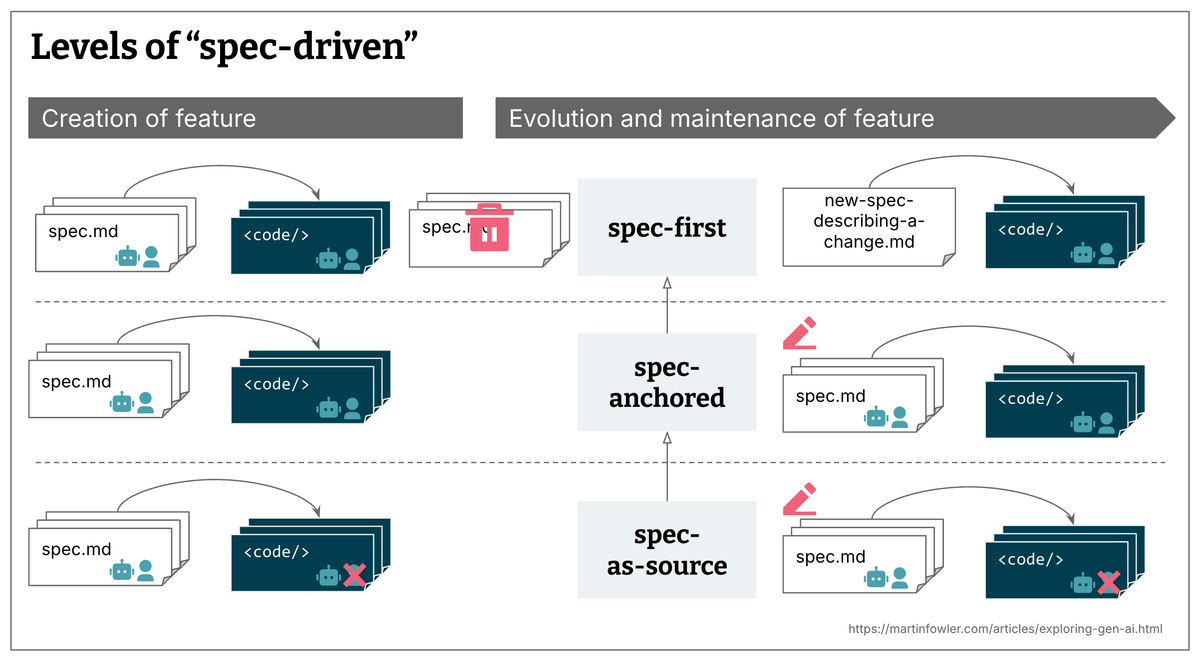Specification-Driven Development (SDD): Analysis and Insights on Kiro, Spec-kit, and Tessl

# Understanding Spec‑Driven Development (SDD) in AI Coding
Spec‑Driven Development (**SDD**) is one of the latest buzzwords in **AI‑assisted coding**. After testing three tools that describe themselves as SDD implementations, I’ve distilled what the concept currently means in practice.
---
## What Is Spec‑Driven Development?
Like many concepts in AI‑driven engineering, the definition of SDD is evolving. Based on current usage, SDD can be summarized as:
> **Documentation‑first** coding with AI: write a structured “spec” before writing any code.
> The spec is the **single source of truth** for both human developers and AI assistants.
### Current References
- [GitHub Spec‑kit](https://github.com/github/spec-kit/blob/main/spec-driven.md):
> *In this new world, maintaining software means evolving specifications… Code becomes the “last‑mile” artifact.*
- [Tessl](https://docs.tessl.io/introduction-to-tessl/concepts):
> *Specs — not code — are the primary artifact. Specs describe intent, and agents generate matching code.*
---
## Levels of Implementation
SDD can be practiced at several levels:
1. **Spec‑First**
Create a spec before coding; it guides the AI on a specific task.
2. **Spec‑Anchored**
Keep the spec after initial delivery; evolve and maintain it as features change.
3. **Spec‑as‑Source**
The spec *is* the authoritative source. Developers edit specs, not generated code.
**Observation:**
All SDD approaches I’ve found are *spec‑first*, but few clearly commit to *spec‑anchored* or *spec‑as‑source* long‑term.
---
## What Counts as a “Spec”?
There’s no universal agreement on what a **spec** is. Most descriptions liken it to a **Product Requirements Document** — but with structure, behavioral focus, and intended for AI agents.
**My working definition:**
> **A spec is a structured, behavior‑oriented artifact — or set of related artifacts — written in natural language that describes functionality and guides AI coding agents.**
### Specs vs. Context
- **Spec:** Relevant only to implementing or modifying a specific feature.
- **Context (Memory Bank):** Broader, persistent documentation — rules, configs, architecture — relevant to *all* AI sessions in the codebase.
Example: [Memory Bank in Cline](https://docs.cline.bot/prompting/cline-memory-bank).
Maintaining this distinction helps with **clarity and maintainability**.
---
## Evaluating SDD Tools
Testing SDD tools realistically is time‑consuming:
- Requires trying greenfield & brownfield projects.
- Needs deeper artifact review, not just surface runs.
- Integration into existing code is often labor‑intensive.
Many open questions remain without long‑term usage reports from real teams.
---
## Tool Overviews
### 1. [Kiro](https://kiro.dev/)
**Workflow:** Requirements → Design → Tasks
- **Spec‑First focus.**
- Requirements formatted as *User Stories* (**As a…**), with acceptance criteria (**GIVEN… WHEN… THEN…**).
- Guides you through 3 Markdown docs inside VS Code.
- Uses a “**memory bank**” called *steering*, with optional docs (`product.md`, `structure.md`, `tech.md`).
**Strengths:** Simple, lightweight structure.
**Weaknesses:** Can feel verbose for small fixes.
---
### 2. [Spec‑kit](https://github.com/github/spec-kit) — GitHub CLI
**Workflow:** Constitution → Specify → Plan → Tasks
- CLI sets up workspaces for coding assistants.
- **Constitution** = immutable high‑level principles applying to every change.
- Produces many interconnected files & checklists per workflow stage.
- Branch per spec suggests *task‑lifecycle*, not *full‑feature lifecycle* anchoring.
**Strengths:** Highly customizable; integrates “living” specifications.
**Weaknesses:** Verbose output; better suited for larger tasks.
---
### 3. [Tessl Framework](https://docs.tessl.io/introduction-to-tessl/quick-start-guide-tessl-framework) *(Private Beta)*
**Workflow Goal:** Spec‑anchored; exploring **spec‑as‑source**.
- CLI + MCP server; can reverse‑engineer specs from code.
- One spec = one code file mapping (for now).
- Generated code marked:// GENERATED FROM SPEC - DO NOT EDIT
- Experimenting with more complex mappings in future.
**Strengths:** Clear spec‑to‑code link; potential for true spec‑as‑source.
**Weaknesses:** Limited abstraction; non‑deterministic outputs can occur.
---
## Observations and Questions
- SDD is **not** a uniform methodology.
- Tools often have **opinionated workflows** — may not fit all problem sizes.
- Potential **overkill**: small fixes can balloon into multiple stories & markdown files.
- Reviewing spec docs can be more tedious than reviewing code.
- **Core needs for effective SDD tools:**
- Flexible workflows for different change sizes.
- Efficient spec review process.
---
## Key Challenges
### Matching Tool to Problem Size
Heavy workflows on small tasks waste effort.
### Markdown Review Fatigue
Excessive, repetitive artifacts slow down work.
### False Sense of Control
LLMs can still ignore, misinterpret, or over‑apply specs despite larger context windows.
### Iteration vs. Overplanning
Up‑front verbose specs clash with agile, iterative feedback loops.
---
## Separating Functional vs. Technical Specs
- The goal: tech stack independence by having AI fill solution details from **functional specs**.
- Reality: difficult to maintain a pure functional layer — boundaries are fuzzy.
---
## Who Is the Target User?
- Many SDD demos assume developers can handle requirements analysis roles usually performed by product managers.
- Likely best for **small to medium tasks** with clear goals — not ambiguous large features.
---
## Lessons from Past: MDD Parallels
- **Model‑Driven Development (MDD):** Specs were models (UML, DSL), generated into code.
- MDD’s overhead & abstraction limited adoption.
- LLMs reduce some overhead — but add **non‑determinism**.
- Spec‑as‑source could inherit **MDD inflexibility** plus LLM unpredictability.
---
## Conclusions
- **Spec‑First** can be valuable — structure matters.
- “Spec‑Driven Development” is loosely defined; often used interchangeably with “detailed prompting.”
- Beware **semantic diffusion**: term losing precision.
- Over‑complicated processes risk becoming *Verschlimmbesserung* — making it worse while trying to improve.
- Effective SDD adoption will require:
- Clear spec definition.
- Scalable workflows.
- Pragmatic integration with existing dev practices.
---
**Final Takeaway:**
SDD offers promise — but must balance **structure** with **agility**. Tooling should fit task size, streamline review, and let teams iterate without excessive upfront overhead.


